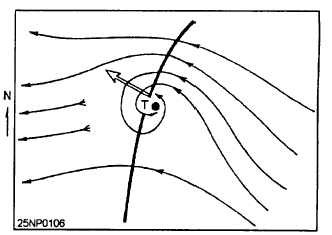. The disturbance is decelerating or moving at a
constant speed.
. The system has a northward component of
motion.
. A migratory anticyclone passes to the north of the
storm center.
. A strong net outflow (divergence) is manifested
by anticyclonic flow in the upper levels (200 hPa).
. Long waves are slowly progressive. (Applicable
to genesis also.)
. The trade inversion is absent; convection deep.
Other considerations to bear in mind:
l Intensification occurs when the cyclone passes
under an upper-level trough or cyclone, provided there
is relative motion between the two. There is some
indication that intensification does not take place when
the two remain superimposed.
. Poleward movement of the cyclone is favorable
for intensification; equatorward motion is not favorable.
. Intensification occurs only in areas where the sea
surface temperature is 79°F or greater, with a high
moisture content at all levels.
l Other factors being equal, deepening will occur
more rapidly in higher than in lower latitudes. (Coriolis
force is stronger.)
l When a storm moves overland, the intensity will
immediately diminish.
The expected amount of
decrease in wind speeds can be 30 to 50 percent for
storms with winds of 65 knots or more; and 15 to 30
percent for storms with less than 65 knots. If the terrain
is rough, there is more decrease in each case than if the
terrain is flat.
Once an intense tropical cyclone has formed, there
will be further changes in its intensity and in the course
of its motion within the Tropics and during recurvature.
The forecaster should consider these changes in
connection with the predicted path of movement.
MOVEMENT
Tropical cyclones usually move with a direction and
speed that closely approximates the tropospheric current
that surrounds them. Logically, therefore, charts of the
mean flow of the troposphere should be used as a basis
for predicting the movement of tropical cyclones, but
lack of observations generally precludes this approach.
Generally there is a tendency for tropical cyclones
to follow a curved path away from the Equator;
however, departures from this type of track are frequent
and of great variety,
Tropical cyclones move toward the greatest surface
pressure falls and toward the area where the surface
pressure falls increase fastest with time. Calculation is
necessary for this rule to be used.
Numerous theories have been advanced to explain
the cyclone tracks of the past and to predict those of the
future. Observational data have never been sufficient to
prove or disprove most of them.
Tropical storms move under the influence of both
external and internal forces. The external forces are a
result of air currents that surround a storm and carry it
along. The internal forces appear to produce a tendency
for a northward displacement of the storm (which
probably is proportional to the intensity of the storm), a
westward displacement that decreases as latitude
increases, and aperiodic oscillation about a mean track.
Initial Movement of Intense Cyclones
The movement of cyclones that are undergoing or
have just completed initial intensification (about 24
hours) will be as follows:
l Storms developing in westward moving wave
troughs in the easterlies move toward the west and also
with a pole ward component given by an angle of
approximately 20° to the right of the axis of the trough
looking downstream. (See fig. 11-1.)
. The motion of storms developing from
preexisting vortices can be extrapolated from the track
of these vortices.
Figure 11-1.-Illustration of initial movement of tropical
cyclones forming in a wave trough In the easterlies.
11-4



